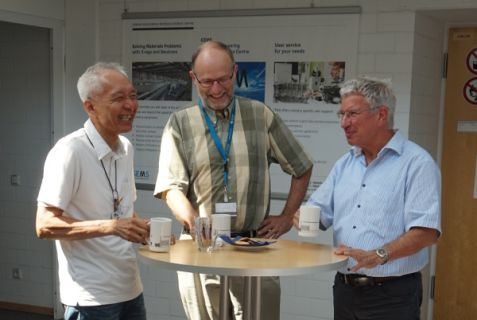MLZ is a cooperation between:
 > Technische Universität München
> Technische Universität München > Helmholtz-Zentrum Hereon
> Helmholtz-Zentrum Hereon
 > Forschungszentrum Jülich
> Forschungszentrum Jülich
MLZ is a member of:
 > LENS
> LENS > ERF-AISBL
> ERF-AISBL
MLZ on social media:

MLZ (eng)
Lichtenbergstr.1
85748 Garching
20.08.2015
Helmholtz International Fellow from Japan is researching in Garching

Dr. Kazuhisa Kakurai (left), this year's winner of the Helmholtz International Fellow Award, arrived at the MLZ and discusses with the MLZ directors Prof. Thomas Brückel (center) and Prof. Winfried Petry (right). © C. Niiranen / FRM II
Dr. Kazuhisa Kakurai, this year’s winner of the Helmholtz International Fellow Award, just arrived at the MLZ. The stay and the experiments he will conduct here at the research neutron source are part of the award.
This possibility for carrying out experiments he appreciates most: “Here in Garching I am interested in studying magnetic systems with complex structures with the small angle scattering diffractometer KWS-2 and chiral magnetic systems with polarized neutrons at the diffractometer POLI”. Especially the latter experiment apparently presents a major challenge, because natural crystals always have left and right rotating magnetic structures. However, Kakurai got crystals with defined chirality: they turn left, right, and he also has a mixed chiral crystal, which he now wants to investigate. He will initially remain until the end of September in Germany, but come back in the next few years to carry out further experiments.
Particularly interesting for Kakurai is that the JCNS has a lot of experience with filters for polarized neutrons; at continuous neutron beams these so-called He3 filters are interesting, but absolutely essential for pulsed neutron sources as the one in Japan. A close cooperation between the Japanese and the German neutron scatterers is suggested, even if “often close cooperation already exists on the personal level” he emphasizes. To intensify this fruitful cooperation in the future is his desire that obviously gets much appreciation from the MLZ-scientists in Garching, as the MLZ-directors Prof. Thomas and Prof. Winfried Petry Brückel stress.
Kakurai speaks excellent German, because he already has spent his high school years in Dusseldorf and then studied physics at the LMU. His former thesis dealt with X-ray scattering studies of defects in crystals at the Chair of Prof. Johann Peisl. He then received his doctorate in the field of neutron scattering with Prof. Hans Dachs and Professor Michael Steiner at the Hahn-Meitner-Institute in Berlin. 1988 he received a request from Professor Yasuo Endoh of the Tohoku University and returned after a total of 25 years in Germany to Japan. The offer contained a special incentive: the neutron source JRR 3 in Tokai was just modernized from the ground up and should get many new modern instruments. A new one, operated by the accelerator neutron source, was planned and realized as a pulsed neutron source at the Japan Proton Accelerator Research Complex (J-PARC) in Tokai. Kakurai continued his career in the neutron scattering group of the Institute of Solid State Physics (ISSP) of the University of Tokyo. 2005, the Japan Atomic Energy Research Institute (JAERI) and Japan Nuclear Cycle Development Institute (JNC) joined the JAEA, the Japan Atomic Energy Agency, that unites various scientific disciplines under one roof. Kakurai was initially group leader of the Polarized Neutron Magnetism Group and later in charge of the Quantum Beam Science Directorate of the JAEA that conducts basic and applied research with neutrons, ions, electrons, positrons and photons. Since 2014 he is a senior consultant, which gives him more freedom to use properly and enjoy such a price and the possibilities it offers.
MLZ is a cooperation between:
 > Technische Universität München
> Technische Universität München > Helmholtz-Zentrum Hereon
> Helmholtz-Zentrum Hereon
 > Forschungszentrum Jülich
> Forschungszentrum Jülich
MLZ is a member of:
 > LENS
> LENS > ERF-AISBL
> ERF-AISBL
MLZ on social media:


